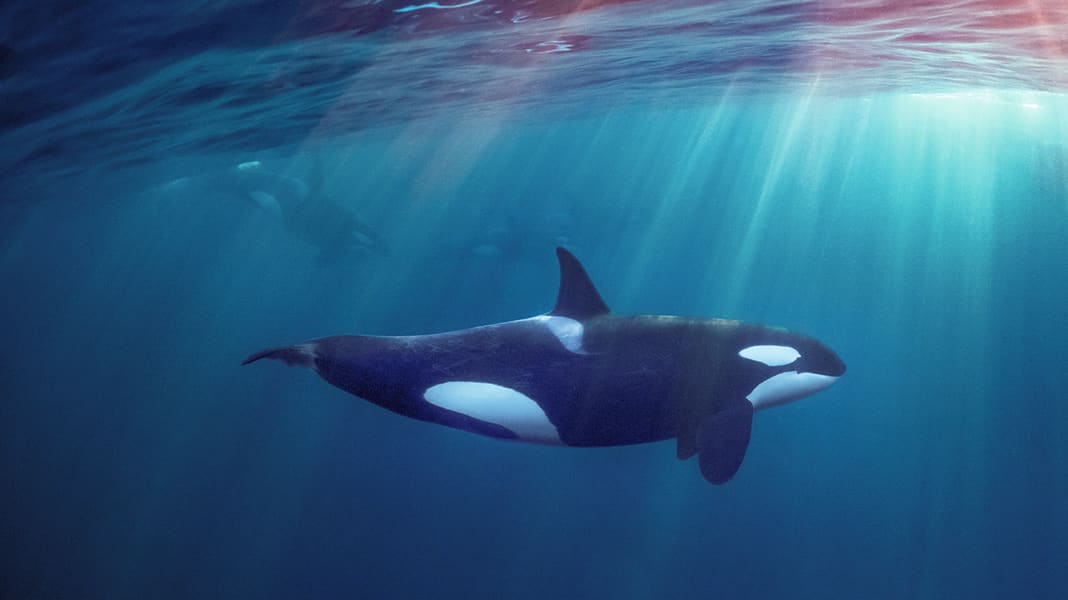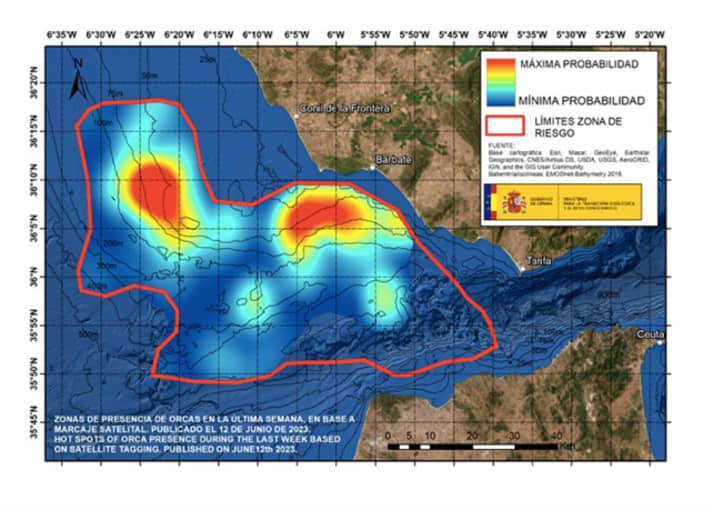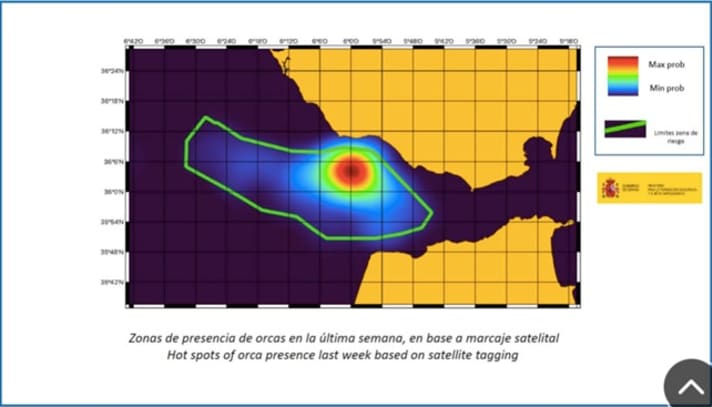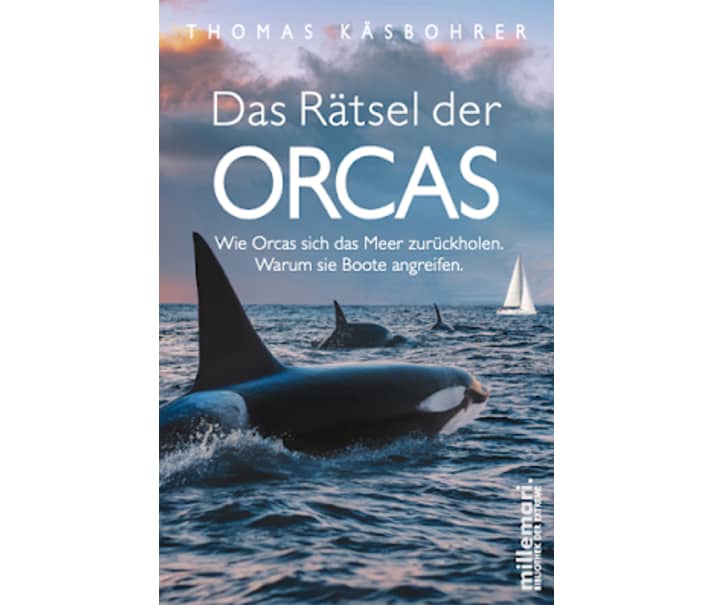Orca attacks: More attacks off Gibraltar - Ocean Race teams at risk? New behavioural guidelines

The final leg of The Ocean Race from The Hague to Genoa passes close to the new risk zone for orca interactions. It is not yet entirely clear whether the crews are sailing into danger. Boris Herrmann says: "The race organisers are aware of the problem and have set up an exclusion zone." Whether this will be enough is questionable.
Risk zone expanded


The Spanish authorities have significantly extended the orca risk zone that was still in place at the beginning of June. In addition to the previous hotspots directly off the fishing village of Barbate and off Tangier, there is now another one around 15 nautical miles to the west. The area outlined in red marks the zone with an increased risk of encountering orcas. The red areas mark the areas in which there were more orcas tagged with satellite transmitters on 12 June and where an encounter was expected with "maximum probability". For the past two months, marine biologists led by whale researcher Renaud de Stephanis have been tagging animals with satellite transmitters in order to be able to visualise their location at any time. Based on the latest orca risk zone, Renaud de Stephanis recommends
Drive close to land! You'll be safe there!"
Back in May, the Spanish Ministry of Transport (Ministerio de Transportes, Movilidad y Agenda Urbana) in Madrid changed its official guidelines for skippers and captains in the event of a rowing attack by orcas. With their latest recommendations, the authorities have made a U-turn. Since 2020, the recommendation in the event of interaction with killer whales has been to stop the yacht, switch off the engine and all equipment in order to make yourself as uninteresting as possible to the animals. According to official estimates, several hundred yacht rudders have been destroyed by killer whales off the Iberian Peninsula since summer 2020 and three yachts have been reported as "sunk due to orca interaction". Unofficial estimates are much higher in both cases.
React correctly to orca attacks
Instead of keeping still, the authorities now advise every yacht in the event of an orca interaction to lower the sails, start the engine and head for the shallowest possible waters as quickly as possible "until the orcas lose interest".
At the same time, the ministry publishes the above map of the current hotspot of orca rowing attacks off Barbate and in its recommendations urgently advises people to seek the immediate vicinity of the coast and shallow water when passing the active killer whales there, as far as the type of construction and wind and sea conditions allow.
In addition, it is pointed out that orcas involved in interactions must be photographed and that every skipper is obliged to report orca interactions.
All other points of the guidelines can be found on the Website of the Ministry as well as the original German translation of the ministerial decree at the end of this article.
Discussion about sand and firecrackers as a means of defence against orcas
The debate about the reliability of sand as a means of deterring orcas continues. Spanish orca and cetacean researcher Renaud de Stephanis remains sceptical about the effect of sand. As intelligent animals, orcas have long since figured out how to avoid the effect of sand on their sensitive sonar detection.
Apart from that, observations of attacked sailors using sand show clear application errors in many videos. Dumping sand at full speed is pointless, because at a speed of five knots through the water it immediately disperses like any other deployed substance. Sand should only be deployed when stationary. Some videos also show far too small quantities of sand being spread by sailors from small bags. Fishermen carry large quantities of sand with them and deploy it in bags from their stationary boats into the water to confuse the perception of sonar hunters.
The effect of firecrackers, known as seal bombs, which fishermen use to repel seals from their nets, was recently reported by former Trans-Ocean board member Martin Birkhoff on his website reported. He experienced two short, violent orca attacks and used so-called fire crackers as a last resort after the expiration, which ended the interactions.
More about orca attacks on sailors:
More information about the mysterious background to the behaviour:

The ministerial decree in German translation:
Recommendations for skippers when killer whales interact with a vessel
If you are at sea and encounter killer whales or other cetaceans and they interact with the vessel, the skipper/captain of the vessel must take the following measures where possible and provided the orcas do not pose a major threat:
- a. Prevent people on board from approaching the railing. Ensure that you are on the ship in places that offer the greatest possible protection from abrupt ship movements. These can also lead to injuries caused by loose objects or even falling overboard.
- b. In the event of an interaction, it is advisable to motor instead of sailing, not to stop the vessel and to head directly for shallow waters at the highest possible speed, as far as the wind and sea allow the vessel concerned, until the killer whales lose interest.
- c. For vessels under sail, attention must be paid to the integrity of the keel and anything that could affect the stability of the vessel. It is therefore recommended that, in the event of an interaction, the sails are recovered and the vessel is lowered under engine power.
- d. It is recommended to sail as close to the coast as possible, as far as vessel safety and the structural characteristics of the vessel allow. This applies in particular off Barbate, where the probability of encountering groups of killer whales close to the coast is lower.
- e. Any vessel or boat that observes the presence of killer whales or other cetaceans, whether or not there has been an interaction, must strictly comply with the provisions of Royal Decree 1727 of 21 December 2007. This establishes measures for the protection of cetaceans, in particular those aimed at avoiding any behaviour that may cause death, harm, harassment or agitation of cetaceans and, in general, all the behaviours listed in Articles 4 and 5 of the aforementioned Royal Decree.
- f. The killer whales involved in an interaction must be observed and, if possible, photographed. These activities may only be carried out in compliance with all precautionary measures and in the exercise of good seamanship, without jeopardising the safety of navigation or the corresponding rules. This should only be done as soon as it is possible and safe to do so without exposing the vessel or boat, the people on board or the cetaceans to any major risks.
- g. Whatever recent instructions or recommendations exist should be passed on to seafarers.
- h. It is recalled that every master or skipper is obliged to report events that pose a danger to navigation. Therefore, interactions with killer whales should be reported to the relevant sea rescue coordination centre.

